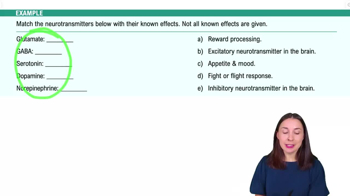Table of contents
- 1. Introduction to Psychology1h 43m
- 2. Psychology Research2h 20m
- 3. Biological Psychology2h 41m
- 4. Sensation and Perception28m
- 5. Consciousness and Sleep32m
- 6. Learning41m
- 7. Memory34m
- 8. Cognition37m
- 9. Emotion and Motivation35m
- 10. Developmental Psychology33m
- 11. Personality48m
- 12. Social Psychology41m
- 13. Stress and Health41m
- 14. Psychological Disorders44m
- 15. Treatment47m
3. Biological Psychology
Communication in the Nervous System
Struggling with Psychology?
Join thousands of students who trust us to help them ace their exams!Watch the first videoMultiple Choice
To help control Chloe's nausea, Chloe's doctor gives her Zofran, which blocks the action of serotonin, a chemical involved in the body's nausea response. In Chloe's case, the medication prescribed by her doctor acts as an
A
excitatory neurotransmitter.
B
inhibitory neurotransmitter.
C
antagonist.
D
agonist.
 Verified step by step guidance
Verified step by step guidance1
Understand the role of neurotransmitters: Neurotransmitters are chemicals that transmit signals across a synapse from one neuron to another. They can be excitatory, promoting the firing of neurons, or inhibitory, reducing the likelihood of neuron firing.
Define the terms: An 'agonist' is a substance that enhances or mimics the action of a neurotransmitter, while an 'antagonist' is a substance that blocks or dampens the action of a neurotransmitter.
Identify the function of Zofran: Zofran is a medication that blocks the action of serotonin, which is a neurotransmitter involved in nausea. By blocking serotonin, Zofran prevents it from binding to its receptors.
Determine the classification: Since Zofran blocks the action of serotonin, it does not enhance or mimic serotonin's effects. Instead, it inhibits serotonin's action by preventing it from binding to its receptors.
Conclude the classification: Based on the definition, a substance that blocks the action of a neurotransmitter is classified as an 'antagonist'. Therefore, Zofran acts as an antagonist in Chloe's case.

 1:20m
1:20mWatch next
Master Electrochemical Communication with a bite sized video explanation from Hannah Gordils
Start learningRelated Videos
Related Practice
































